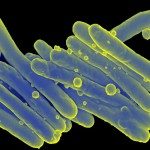Lien vers Pubmed [PMID] – 26082120
Microbiol Spectr 2014 Feb;2(1):MGM2-0025-2013
Most mycobacterial species are harmless saprophytes, often found in aquatic environments. A few species seem to have evolved from this pool of environmental mycobacteria into major human pathogens, such as Mycobacterium tuberculosis, the agent of tuberculosis, Mycobacterium leprae, the leprosy bacillus, and Mycobacterium ulcerans, the agent of Buruli ulcer. While the pathogenicity of M. ulcerans relates to the acquisition of a large plasmid encoding a polyketide-derived toxin, the molecular mechanisms by which M. leprae or M. tuberculosis have evolved to cause disease are complex and involve the interaction between the pathogen and the host. Here we focus on M. tuberculosis and closely related mycobacteria and discuss insights gained from recent genomic and functional studies. Comparison of M. tuberculosis genome data with sequences from nontuberculous mycobacteria, such as Mycobacterium marinum or Mycobacterium kansasii, provides a perception of the more distant evolution of M. tuberculosis, while the recently accomplished genome sequences of multiple tubercle bacilli with smooth colony morphology, named Mycobacterium canettii, have allowed the ancestral gene pool of tubercle bacilli to be estimated. The resulting findings are instrumental for our understanding of the pathogenomic evolution of tuberculosis-causing mycobacteria. Comparison of virulent and attenuated members of the M. tuberculosis complex has further contributed to identification of a specific secretion pathway, named ESX or Type VII secretion. The molecular machines involved are key elements for mycobacterial pathogenicity, strongly influencing the ability of M. tuberculosis to cope with the immune defense mounted by the host.

